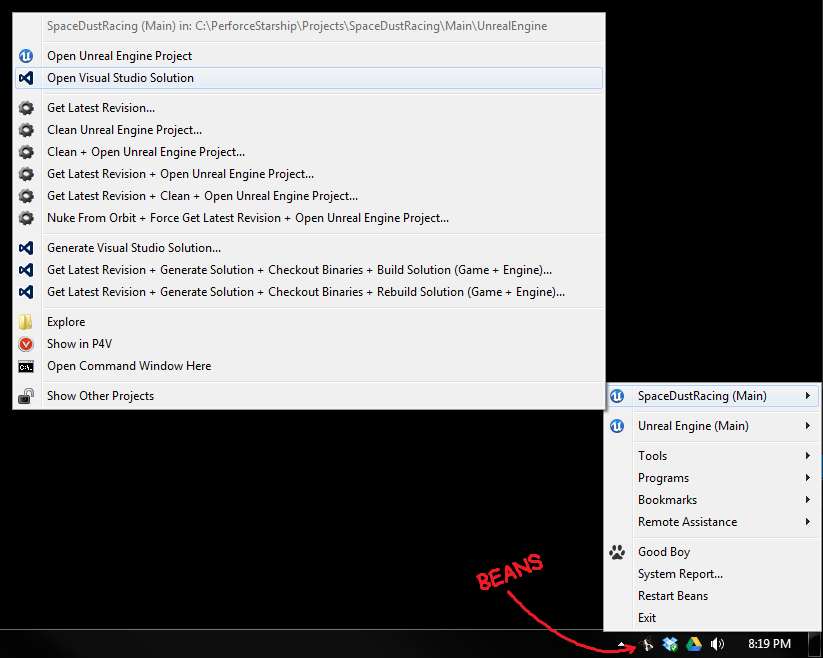Ahh, the corporate video game lifestyle. quad 24″ monitors, $1000 office chairs, free snacks, and beer o’clock. But when you and four colleagues throw that lifestyle away to pursue your indie game dev dreams, more often than not you can’t (and shouldn’t) rent a fancy office, because in case you weren’t paying attention, you’re now peasants and every cent counts. But with the right tools and processes, you can work together remotely on a tight budget.
In this three-part article, I’ll run through the tools and processes we use for remote game development at Space Dust Studios. Part 1 focuses on communication, Part 2 focuses on collaboration, and Part 3 focuses on security and backups. We’ve evolved this setup over the last 12 months and it’s working well for us, though we’re a team of five living in the same city, so your mileage may vary. If you’re working with a bigger team or are spread across different time zones, you may need to make some changes.
We’re always on the lookout for improvements, so please leave a comment if you’ve got suggestions!
Part 2. Collaboration
Office software
You can probably get away with a cloud-based office suite like Google Docs for most of the work you’ll be doing, but occasionally you’ll need something a bit richer in features, particularly with spreadsheets and presentations. The main thing here is to be consistent – pick a standard office suite (Libre Office is a good free suite, or alternatively see if you’re eligible for Microsoft’s Bizspark program for the Office suite – thanks to reader Doolwind!) and make sure everyone is using that version. Document it as part of the team setup instructions on the wiki.
Task tracking
There are many all-in-one cloud-based project management solutions around, such as Asana, Basecamp, JIRA, Producteev.and Proofhub. But we like keeping things simple, so unsurprisingly we’re huge fans of Trello (shameless referral link) for its bare bones functionality and transparency across the team… plus it’s free!
We use Trello for agile task tracking, bug and issue tracking, items for our meeting agenda, temporary notes and instructions (when the wiki just feels too permanent), and for keeping a running task backlog (ie. stuff that’s not relevant right now, but we don’t want to forget about). In total we’ve got eight lists: Meeting agenda, Task Backlog, Temporary Notes, Michael, Nathan, Glen, Grigor, Stephen.
When we’re holding a meeting, one of us keeps Trello open and runs through the meeting agenda items. Items stay put if they’re to be discussed further in the next meeting, or move onto individual task lists as actions, or move into the backlog if we’re postponing them. At the end of the meeting, we quickly review our own task lists and the task backlog to see if anything needs adjusting, then we’re done. It’s a pretty simple system that anyone can drive, refer back to later, and it updates easily from a laptop or smartphone.
File sharing
It used to be Dropbox (shameless referral link) or bust, but now we’re spoiled for choice: Box, Google Drive and SkyDrive are viable alternatives, and there are many other open-source options around if you want to run your own service.
For internal file sharing we prefer Google Drive, because its integration with Google Docs allows us to keep our web-based wiki documents and files in the same hierarchy.
For external file sharing with partners and clients we’ve gone with Dropbox, partly because it’s a well-known (and thus perceived as trustworthy) service, but mostly because it’s dead simple to share folder links, and it also provides a rich web interface to quickly preview and download files, which is quite important when you’re sharing large videos, PDFs and images for your game.
We use file sharing for any assets that don’t need to be version controlled. If something is a source asset for a build (such as a website or a game), it lives under version control, otherwise it goes into file sharing. For more information on why this is a good idea, see section 5 (Builds) of Perforce’s white paper High-Level Software Version Management Best Practices.
We also place the binaries for important milestone builds in file sharing, so everyone has quick access to working builds for unexpected demos.
Version control
You absolutely need proper version control to develop games. Here’s why. There are many free options out there for version control, but video games are a very specific subset of software development. They often require non-technical people to commit changes, and the assets extend far beyond code, including binary file formats such as 3D models, audio, video and music. The repositories can get big, fast! So I’m going to strongly recommend the one version control that’s never ever failed me in 12 years of video game development:
Perforce. It’s the industry standard, and is free for up to 20 users and workspaces. It integrates with many game engines out of the box, and is a centralized version control system, meaning it’s simpler for artists and designers to learn how to use as there are less steps involved, plus the user interface tends to be a lot simpler than open-source alternatives. (Sorry Git.)
One great feature of Perforce is shelving. You can quickly stash unfinished local changes into a safe place on the server then revert them from your local build, allowing you to quickly task-switch and keep changes grouped together logically. Others can also review your shelved changes on the server, which is really useful for doing remote code reviews. They can also unshelve the changes as their own to continue where you left off. Other version control solutions offer similar features, but none make it quite as easy as Perforce does (in my humble opinion).
Another great feature is the ability to see other users’ pending changelists. If someone hasn’t checked their email and they’re not on IM, you’re still able to identify what they’re working on, and avoid stepping on their toes.
You can run a Perforce server on just about any platform, locally or in the cloud. I’ve got ours running on a small Windows 7 HTPC in my lounge room, mostly because we’re not ready to pay a monthly fee for dedicated hosting. It’s not the fastest connection in the world (and this is where dedicated hosting shines), but if team members do most of their big syncs overnight with a build script, you can avoid major headaches during the day.
Continuous integration
We actually don’t do this step yet (it’s on our to do list), but it’s good practice to have a dedicated build machine somewhere that’s constantly pulling down tip from version control, making all combinations of the build, and notifying everyone if there are any problems. Bonus points if it pinpoints a changelist range that broke the build and emails those who broke it. Extra bonus points if you alert users about to grab tip from version control when there are problems.
A busted build in version control, or a build littered with debug asserts, is a huge time waster for everyone. It happens from time to time, and on smaller teams it’s less of an issue, but you’ll really want continuous integration as you scale up, otherwise your team productivity is going to take a big hit. You can author a build monitor script in just about any language, but the fine details will depend heavily on the engine and tech you’re using.
Code reviews
As a general policy, we don’t allow any code changes into version control unless they’ve been reviewed by someone else. This is great for catching bugs before they make it into the build. It forces you to think twice about what you’re submitting, and to self-review before you ask someone else to take a look. It’s strongly encouraged to run through your changes line-by-line before asking anyone else to take a look, if only to save you the embarrassment of accidentally code reviewing (or worse, checking in) debug code.
Check-in descriptions
It’s tempting to skip writing up proper changes for version control, but the bigger a project gets, the more likely you are to start digging through file histories. Nothing is more infuriating than coming across changelists that touch 34 separate files with the changelist description “LOL refactored!! #yolo”. Create a check-in description template, with a checklist attached, and enforce the template for all code checkins. Future you will say thank you. Here’s ours for reference:
[Project Identifier] One-sentence summary More detailed summary of the changes. A short paragraph is ideal. <Optional: Bug/task ID and URL to project management software> Built: <which profile did you build? debug/release etc.> Tested: <which level did you test?> Code review buddy: <who did the code review?> Check-in checklist - delete this section when done: - Reconcile offline work (ensure no files are missing from the changelist). - Add a one-sentence summary to the top of any new source files with author and date. - Ensure all new functions have sensible asserts for parameters. - Ensure any non-obvious code is commented appropriately. - Are there any code smells? Refactor and re-test before checking in, while it's still fresh! - Is there more than one logical change in this changelist? If so, split it into two changelists before checking in.
Desktop build helper
Meet Beans, the Space Dust Studios desktop build helper! He’s an abomination of this Python script, which we’ve re-appropriated to handle all of our repetitive tasks and actions.
A system-tray build helper like this comes in really handy as you move through production, mostly for the time and stress it saves on performing repetitive actions, particularly for content creators who may not have the programmer know-how to automate their own tasks.
For each project, Beans can clean the project folder out, re-sync from Perforce, nuke it from orbit (it’s the only way to be sure!), and rebuild code solutions. He can also batch operations together, so you can set and forget him, then make yourself a cup of tea or retire for the evening. Beans also contains shortcuts to commonly used programs and web bookmarks, and hooks into the Windows Remote Assistance tool, which means we can easily remote desktop into each others’ machines when we’re experiencing technical troubles and need someone to hold our hand.
Obviously there’s lots of potential with a build helper to make everyone’s day-to-day lives easier, so it’s good practice to regularly ask team members what’s making them want to die in terms of the pipeline, and seeing if there’s easy ways to automate repetitive actions within the desktop build helper.
Beans has a lot of room for improvement. He’s lacking a command-line interface for scripting, and he doesn’t notify us about broken builds. But these can come later… to start, aim to make the lives of content creators easier.
Everything outlined above is working well for us now, but as we ramp up our team and projects we’ll most certainly need to get office space. But for that awkward period between starting your company and bringing home the bacon, hopefully the tools and processes I’ve covered here will help get your team and project moving along for very little financial investment.
Have we missed something? Please let us know in the comments and we’ll add it to the post!

